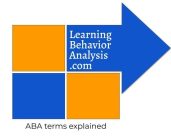A-4: Distinguish among behaviorism, the experimental analysis of behavior, applied behavior analysis, and professional practice guided by the science of behavior analysis ©
Want this as a downloadable PDF? Click here!
Target Terms: Behaviorism, Experimental Analysis of Behavior (EAB), Applied Behavior Analysis, Professional Practice Guided by the Science of Behavior Analysis

Behaviorism
Definition: The philosophy of the science of behavior. It emphasizes objective methods of investigation and is rooted in the assumption that behavior results from interactions between the environment and individual variables (such as prior learning history).
Example in everyday context: Your friend is uncharacteristically “snappy” with you over the phone one night. In deciding how to respond to the situation, you operate from the assumption that there is a scientific explanation for this behavior. (You do not assume that “She’s just being mean for no reason!”)
Example in clinical context: You are teaching a client self-management strategies to help them with their overeating behavior. You instruct them to remove all junk food from their home, since you know that when the client sees junk food, they are more likely to eat it. You also instruct your client to avoid the junk food aisles at the grocery store and to only shop the perimeter of the store since that is where the healthy options are. Behaviorism is at work, since you are assisting the client with altering their environment to reduce stimuli that occasion overeating behavior, while providing them with alternative options to meet their goals.
Example in supervision/consultation context: A teacher is making the classroom schedule for the day. They make sure to proactively structure reinforcement following transitions, since this is a time that the students in the class historically have engaged in the most problematic behavior. The teacher is exercising an understanding of behaviorism, since they are taking precautions to arrange the environment in such a way to promote the most success from their students.
Why it matters: Behaviorism encourages that hypotheses be tested using experimental methods and that environmental conditions be explored. Behaviorism is understanding how the environment works so that behavior can be understood in context.
Experimental Analysis of Behavior (EAB)
Definition: The scientific study of behavior to study behavior for its own sake.
Example in clinical context: A researcher in a lab is studying the effects of various reinforcement schedules using mice as subjects. The mice complete a maze and receive food along the way. The researcher finds that mice complete the maze faster when they used a variable ratio schedule of reinforcement rather than a fixed interval schedule of reinforcement.
Why it matters: EAB does not investigate the social validity or relevance of behavior. Though it provides a solid scientific foundation for behavior principles to be used in real word settings outside of the laboratory, it is not in itself applied research.
Applied Behavior Analysis
Definition: The application of behavioral principles to human subjects as it related to areas that matter to people (e.g., classroom management, instructional methods, generalization and maintenance of learning, health and fitness, communication, etc).
Example in clinical context: A clinician is studying the effects of a token economy with a group of subjects in a clinic who all present with aggressive outbursts. The hypothesis of the study is that the implementation of a token economy will decrease the amount of verbal aggressive outburst the subjects.
Example in supervision/consultation context: A doctoral student is conducting their dissertation research in a school setting on learning outcomes of students using direct instruction verses an alternative instructional method. They want to compare which instructional method has the greatest learning outcomes for students.
Why it matters: Applied behavior analysis uses the methods of experimental analysis of behavior and applies it to human subjects. Participants of this research benefit by learning new behaviors which improves their quality of life. The integration of scientific inquiry and person-centered clinical programming is central to the practice of ABA.
Practice Guided by the Science of Behavior Analysis
Definition: Delivery of interventions to clients that are guided by the principles of behaviorism and the research of experimental analysis of behavior and applied behavior analysis.
Example in clinical context: A behavioral psychologist is implementing a chaining procedure to teach a client how to interact safely with a sibling. The intervention steps, including when to provide reinforcement, are guided by the research in applied behavior analysis.
Example in supervision/consultation context: A behavior specialist is demonstrating to a teacher how to conduct a functional communication training by teaching a student to say “No”. The intervention is guided by the research in applied behavior analysis.
Why it matters: Behavioral principles can be applied to real world situations, in order to help people, in a wide array of contexts and by a variety of different interventionists.
